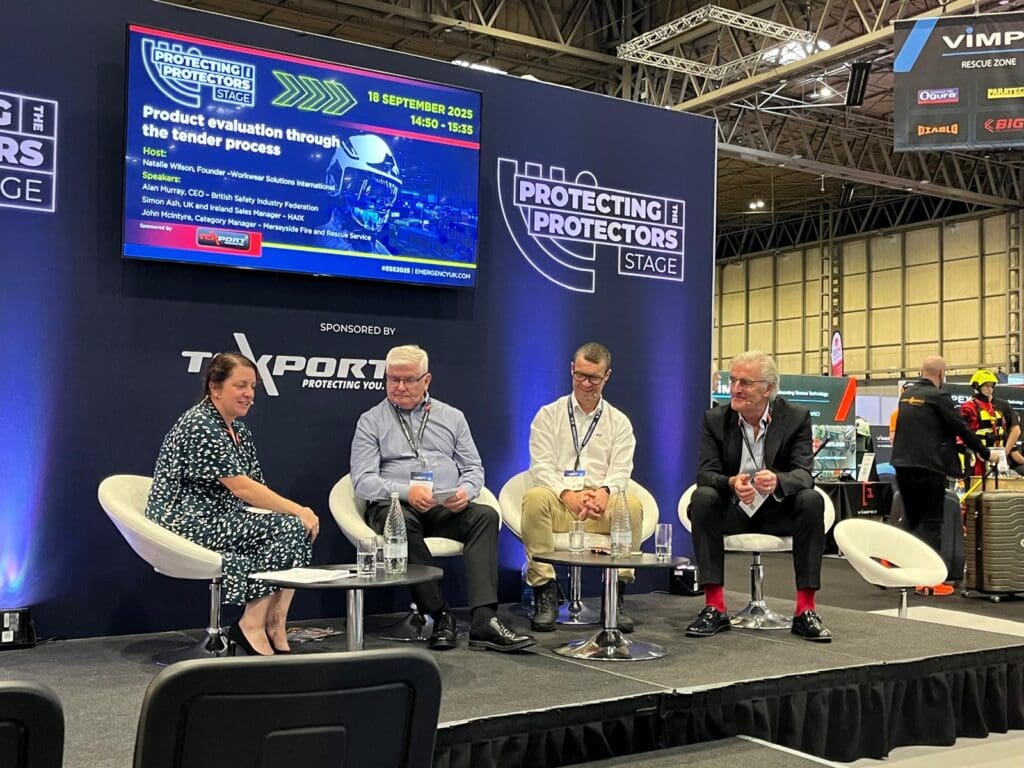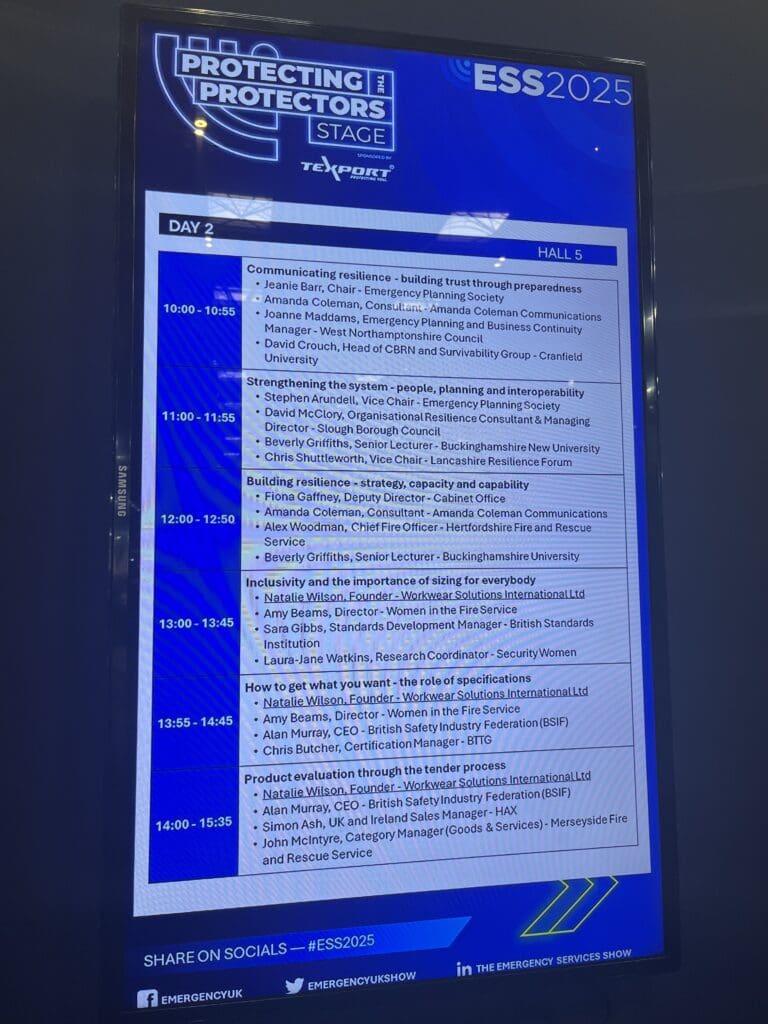On Thursday the 18th of September, our team attended the Emergency Services Show at the NEC, Birmingham. Innovation, collaboration, and the spirit of the blue-light community was in full force at this year’s ESS – from striking uniform displays and cutting-edge technology demos to inspiring panel discussions on the challenges and opportunities facing the UK’s emergency services network. The day brought together professionals from across the sector to share ideas, forge connections and celebrate the work that is keeping our communities safe.
Here’s our teams personal highlights and insights from Thursday at the Emergency Services Show 2025.
The Health Implications of Ill-fitting Uniforms
Sarah attended 2 engaging presentations at the EST Studios & the People and Skills Stage – both promoting inclusive and fit-for-purpose uniforms and PPE.
11:30am Supplier Session: Why the Right Sports Bra Matters in Emergency Services.
Jenny Burbage (Associate Professor in Applied Biomechanics & Women’s Health @ the University of Portsmouth) and Charly Rhodes (Director and Sports Bra Expert @ boobydoo) discussed why the right sports bra matters, especially in the physically demanding roles within the sector. The stand-out point of discussion was how poor breast support and ill-fitting body armour affect the physical and mental health of female colleagues in the emergency services.
12:00pm Panel questioning: If Police Uniform Is ‘Unfit For Purpose’, What Can Be Done To Improve It?’.
On the People and Skills Stage – ‘a platform focused on resilience, wellbeing, leadership, and inclusion’ – Dr Camilla de Camargo and Dr Stephanie Wallace explored the effect of ill-fitting uniforms on health, taking a deep dive into the National Uniform and Equipment Survey. Both women are Lecturers in Criminology at Lancaster University, and they led the survey with the Police Federation.
They shared the eye-opening results:
➡️ 51% said their uniform is not fit for purpose.
➡️ 64% said their uniforms restricts movement while on duty.
➡️ 85% of female officers and 62% of male officers reported at least one health issue linked to their uniform.
➡️ 69% of users identified their cargo trousers as the most unsuitable item of clothing, with some cases of causing serious harm to genital health and increased infections.
For more information on this survey from the Police Federation, please visit: https://www.polfed.org/resources/national-uniform-equipment-survey/

Hosting Panels at the Protecting the Protectors Stage
Throughout the afternoon on day two our Founder & MD Natalie hosted back-to-back panels at the Protecting the Protectors Stage, having spent the morning networking with new and existing contacts.
The first panel ‘Inclusivity and the Importance of Sizing for Every Body’ discussed the newly launched BS30417 Provision of Inclusive PPE – Guide. Natalie was joined by Sara Gibbs (BSI), Amy Beams (Women in the Fire Service) and Laura-Jane Watkins (SecurityWomen) for this important discussion.
Fit for Form was the overarching message, and how understanding body measurements is important to ensure the suitability of uniforms and PPE for modern workforces. It was noted that legislation isn’t up to date with today’s evolving landscape of equality and inclusion, and with the last anthropometric data having been collected in 2006, are we even aware of what this landscape looks like today?
Rebekah’s key-takeaway of the discussion was how many users of PPE feel uncomfortable giving feedback on the fit and function of their uniforms, fearing it will be seen as complaining. This mindset, coupled with concerns that uniforms won’t fit properly, could discourage people from joining or staying in the industry. The message was clear: we need to create environments where individuals can be themselves at work and not feel the need to change to fit their uniform/equipment.
Despite this conversation being primarily gender focused, it was noted that inclusivity means more than female and male fit. It encompasses ethnicity, religion, body shape, neurodiversity, hormonal changes, and more – all of which the new BS30417 Standard importantly represents.



Natalie’s second panel was named ‘How to Get What you Want – the Role of Specifications’. This discussion spoke with experts from Women in the Fire Service (Amy Beams), Notified Body Shirley / BTTG (Chris Butcher) and The British Safety Industry Federation (Allan Murray).
The stand-out point was how those who wear PPE, deserve PPE – we must protect the protectors. First and foremost, it was made clear this is not about specifying brands or preferred products but ensuring that specifications are an accurate reflection of the needs of wearers and users.
Setting the right standard of requirements for PPE should happen at the start of the technical process. Starting with the user, we must ensure that all safety regulations, certifications, and user requirements are considered from the outset. This will then avoid the risk to the user, delays to the provision of the product, and costs to the provider.
Speakers questioned which standards are limiting product specifications and explored whether testing methods are adapting to the modern, changing workforce. They also noted how product allocations and order volumes can directly influence testing demands and delivery schedules. Understanding the new realities of the industry, and specifically the realities people face on the job is essential – and open communication between testing houses and end users will be key.
Natalie’s third and final panel was on Product Evaluation through the Tender Process.
Hosting Allan Murray, Simon Ash (HAIX) and John McIntyre (MFRS), the panel discussed the benefits and challenges faced throughout the tender process in relation to product evaluation, specifically focusing on the often-missing link between wearer trials and specifications.
It was explained the benefits of incorporating wearer evaluations, with clearly defined assessment processes communicated at the start of a tender process. When implemented effectively, and transparent in its findings, wearer trials can ultimately improve the outcome of a tender.
Discussions included the good, the bad and the ugly experiences of buyers and suppliers where trials form part of the evaluation process. Best practice was discussed in terms of: including triallists who are representative of the workforce as a whole, ensuring fairness by each wearer trialling all tenderer’s products (to avoid personal preference bias), and establishing processes that will result in transparent feedback.

Despite the different topics covered, Natalie identified key themes that impacted all the sessions, namely:
➡️ The importance of always starting with the wearer: understanding the needs of a workforce should be the first stage in the development of any uniform or PPE items. This knowledge and feedback needs to drive specification requirements to ensure the final items are fit for form and fit for purpose.
➡️ Inclusivity is only effective if built into procurement processes from pre-tender industry & wearer engagement through to wearer evaluations (with diverse representation), and on-going feedback throughout a contract life.
What was also apparent through the panel discussions and general conversations at the event is a fundamental missing link in many procurement processes. Buyers, and buying organisations, issue specifications at the tender stage and then often move straight to wearer trials (sometimes without pre-qualification).
Without completing any technical sample evaluation before going to wearer trial, there’s a risk that wearers are trialling products that may pose some level of risk (protective qualities, comfort or fit), and that may have been eliminated from the process as part of an in-depth technical evaluation. We would ask buyers to consider who is undertaking tender sample assessment? What are they evaluating, and how is this being built into tender processes to reduce this risk?

After a day full of insights, innovation, and engaging conversations, the Emergency Services Show 2025 delivered plenty to reflect on. We will certainly be back for ESS 2026!